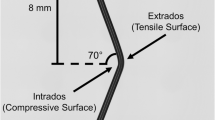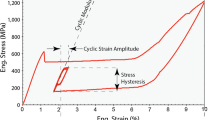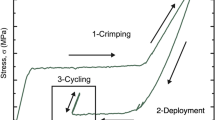Abstract
Nitinol implants, especially those used in cardiovascular applications, are typically expected to remain durable beyond 108 cycles, yet literature on ultra-high cycle fatigue of nitinol remains relatively scarce and its mechanisms not well understood. To investigate nitinol fatigue behavior in this domain, we conducted a multifaceted evaluation of nitinol wire subjected to rotary bend fatigue that included detailed material characterization and finite element analysis as well as post hoc analyses of the resulting fatigue life data. Below approximately 105 cycles, cyclic phase transformation, as predicted by computational simulations, was associated with fatigue failure. Between 105 and 108 cycles, fractures were relatively infrequent. Beyond 108 cycles, fatigue fractures were relatively common depending on the load level and other factors including the size of non-metallic inclusions present and the number of loading cycles. Given observations of both low cycle and ultra-high cycle fatigue fractures, a two-failure model may be more appropriate than the standard Coffin-Manson equation for characterizing nitinol fatigue life beyond 108 cycles. This work provides the first documented fatigue study of medical grade nitinol to 109 cycles, and the observations and insights described will be of value as design engineers seek to improve durability for future nitinol implants.













Similar content being viewed by others
Data Availability
The experimental fatigue life dataset is provided with this published article as a supplementary file. All other datasets are available from the corresponding author on reasonable request.
Notes
\(\Phi \left(x\right)=P\left(Z\le x\right)=\frac{1}{\sqrt{2\pi }}\underset{-\infty }{\overset{x}{\int }}\mathrm{exp}\left\{-\frac{{u}^{2}}{2}\right\}\mathrm{d}u.\)
Due to numerical convergence issues, the parameter \({\varepsilon }_{50}\) was “hard” set to 0.56% strain rather than identified using maximum likelihood techniques. This choice for \({\varepsilon }_{50}\) was based on inspection of the observed cycles to fracture data. Samples run at this nominal strain level of 0.56% saw roughly equal proportions fracture before and after 10 million cycles. As a result of setting the parameter, the fit of the \({\varepsilon }_{50}\) parameter may not be optimal, and the confidence bounds on \({\varepsilon }_{50}\) could not be calculated. Work to improve the numerical algorithm to treat \({\varepsilon }_{50}\) as a true model parameter is ongoing.
References
Gbur JL, Lewandowski JJ (2016) Fatigue and fracture of wires and cables for biomedical applications. Int Mater Rev 61(4):231–314
Mahtabi MJ, Shamsaei N, Mitchell MR (2015) Fatigue of Nitinol: The state-of-the-art and ongoing challenges. J Mech Behav Biomed Mater 50:228–254
Pelton, A., Berg, B., Saffari, P., Stebner, A., and Bucsek, A., Pre-strain and Mean Strain Effects on the Fatigue Behavior of Superelastic Nitinol Medical Devices. Shape Memory and Superelasticity, 2022: p. 1–21.
Pelton, A., Pelton, S., Jörn, T., Ulmer, J., Niedermaier, D., Plaskonka, K., LePage, W., Saffari, P., and Mitchell, M. The quest for fatigue-resistant nitinol for medical implants. in Fourth symposium on fatigue and fracture of metallic medical materials and devices. 2019. ASTM International.
Robertson S, Pelton A, Ritchie R (2012) Mechanical fatigue and fracture of Nitinol. Int Mater Rev 57(1):1–36
Fitzka M, Rennhofer H, Catoor D, Reiterer M, Lichtenegger H, Checchia S, di Michiel M, Irrasch D, Gruenewald T, Mayer H (2020) High Speed In Situ Synchrotron Observation of Cyclic Deformation and Phase Transformation of Superelastic Nitinol at Ultrasonic Frequency. Exp Mech 60(3):317–328
Adler P, Frei R, Kimiecik M, Briant P, James B, Liu C (2018) Effects of tube processing on the fatigue life of nitinol. Shape Memory and Superelasticity 4(1):197–217
Bonsignore C, Shamini A, Duerig T (2019) The Role of Parent Phase Compliance on the Fatigue Lifetime of Ni–Ti. Shape Memory and Superelasticity 5(4):407–414
Pelton AR, Fino-Decker J, Vien L, Bonsignore C, Saffari P, Launey M, Mitchell MR (2013) Rotary-bending fatigue characteristics of medical-grade Nitinol wire. J Mech Behav Biomed Mater 27:19–32
Robertson SW, Launey M, Shelley O, Ong I, Vien L, Senthilnathan K, Saffari P, Schlegel S, Pelton AR (2015) A statistical approach to understand the role of inclusions on the fatigue resistance of superelastic Nitinol wire and tubing. J Mech Behav Biomed Mater 51:119–131
Tobushi H, Hachisuka T, Yamada S, Lin PH (1997) Rotating-bending fatigue of a TiNi shape-memory alloy wire. Mech Mater 26(1):35–42
Wagner M, Sawaguchi T, Kaustrater G, Hoffken D, Eggeler G (2004) Structural fatigue of pseudoelastic NiTi shape memory wires. Materials Science and Engineering a-Structural Materials Properties Microstructure and Processing 378(1–2):105–109
Cheng, C., Handbook of vascular motion. 2019.
Gupta S, Pelton AR, Weaver JD, Gong XY, Nagaraja S (2015) High compressive pre-strains reduce the bending fatigue life of nitinol wire. J Mech Behav Biomed Mater 44:96–108
Patel, M.M. and Gordon, R.F. An investigation of diverse surface finishes on fatigue properties of superelastic Nitinol wire. in SMST-2006 Proceedings of the International Conference on Shape Memory and Superelastic Technologies. 2006. Citeseer.
Schaffer JE, Plumley DL (2009) Fatigue performance of nitinol round wire with varying cold work reductions. J Mater Eng Perform 18(5):563–568
Urbano M, Cadelli A, Sczerzenie F, Luccarelli P, Beretta S, Coda A (2015) Inclusions Size-based Fatigue Life Prediction Model of NiTi Alloy for Biomedical Applications. Shape Memory and Superelasticity 1(2):240–251
Weaver J, Sena G, Falk W, Sivan S (2022) On the influence of test speed and environment in the fatigue life of small diameter nitinol and stainless steel wire. Int J Fatigue 155:106619
Cao H, Wu MH, Zhou F, McMeeking RM, Ritchie RO (2020) The influence of mean strain on the high-cycle fatigue of Nitinol with application to medical devices. J Mech Phys Solids 143:104057
Rahim M, Frenzel J, Frotscher M, Pfetzing-Micklich J, Steegmuller R, Wohlschlogel M, Mughrabi H, Eggeler G (2013) Impurity levels and fatigue lives of pseudoelastic NiTi shape memory alloys. Acta Mater 61(10):3667–3686
Bathias C (1999) There is no infinite fatigue life in metallic materials. Fatigue & fracture of engineering materials & structures (Print) 22(7):559–565
Murakami, Y., Takada, M., and Toriyama, T., Super-long life tension–compression fatigue properties of quenched and tempered 0.46% carbon steel. International Journal of Fatigue, 1998. 20(9): p. 661–667.
Murakami, Y., Metal fatigue: effects of small defects and nonmetallic inclusions. 2019: Academic Press.
ASTM F2063–12, Standard Specification for Wrought Nickel-Titanium Shape Memory Alloys for Medical Devices and Surgical Implants, ASTM International.
ASTM F2082–16, Standard Test Method for Determination of Transformation Temperature of Nickel-Titanium Shape Memory Alloys by Bend and Free Recovery, ASTM International.
ASTM F2516–18, Standard Test Method for Tension Testing of Nickel-Titanium Superelastic Materials, ASTM International.
ASTM F2004–17, Standard Test Method for Transformation Temperature of Nickel-Titanium Alloys by Thermal Analysis, ASTM International.
ASTM E384–17, Standard Test Method for Microindentation Hardness of Materials, ASTM International.
ASTM E3–11, Standard Guide for Preparation of Metallographic Specimens, ASTM International.
ASTM E407–07, Standard Practice for Microetching Metals and Alloys, ASTM International.
ASTM E2283–08, Standard Practice for Extreme Value Analysis of Nonmetallic Inclusions in Steel and Other Microstructural Features, ASTM International.
Schneider CA, Rasband WS, Eliceiri KW (2012) NIH Image to ImageJ: 25 years of image analysis. Nat Methods 9(7):671–675
Aycock KI, Rebelo N, Craven BA (2020) Method of manufactured solutions code verification of elastostatic solid mechanics problems in a commercial finite element solver. Comput Struct 229:106175
Rebelo N, Perry M (2000) Finite element analysis for the design of nitinol medical devices. Minim Invasive Ther Allied Technol 9(2):75–80
Auricchio F, Taylor RL (1997) Shape-memory alloys: modelling and numerical simulations of the finite-strain superelastic behavior. Comput Methods Appl Mech Eng 143(1–2):175–194
Pedregosa, F., Varoquaux, G., Gramfort, A., Michel, V., Thirion, B., Grisel, O., Blondel, M., Prettenhofer, P., Weiss, R., and Dubourg, V., Scikit-learn: Machine learning in Python. the Journal of machine Learning research, 2011. 12: p. 2825–2830.
Marrey, R., Baillargeon, B., Dreher, M.L., Weaver, J.D., Nagaraja, S., Rebelo, N., and Gong, X.-Y., Validating Fatigue safety factor calculation methods for cardiovascular stents. Journal of biomechanical engineering, 2018. 140(6).
Craven BA, Aycock KI, Manning KB (2018) Steady flow in a patient-averaged inferior vena cava—Part II: Computational fluid dynamics verification and validation. Cardiovasc Eng Technol 9(4):654–673
Roache PJ (1994) Perspective: A Method for Uniform Reporting of Grid Refinement Studies. J Fluids Eng 116(3):405–413
Guler, I., Aycock, K., and Rebelo, N. , Two Calculation Verification Metrics used in the Medical Device Industry: Revisiting the Limitations of Fractional Change. The Journal of Verification, Validation, and Uncertainty Quantification (JVVUQ), 2022 (Accepted).
Pelton A, Huang G, Moine P, Sinclair R (2012) Effects of thermal cycling on microstructure and properties in Nitinol. Mater Sci Eng, A 532:130–138
Castillo, E. and Fernández-Canteli, A., A unified statistical methodology for modeling fatigue damage. 2009: Springer Science & Business Media.
Meeker WQ, E.L., Pascual FG, Hong Y, Falk WM, Ananthasayanam B, Liu P, Modern Statistical Models and Methods for Estimating Fatigue-Life and Fatigue-Strength Distributions from Experimental Data. (in preparation).
Falk, W. A Statistically Rigorous Fatigue Strength Analysis Approach Applied to Medical Devices. in Fourth Symposium on Fatigue and Fracture of Metallic Medical Materials and Devices. 2019. ASTM International.
Sakai T, Lian B, Takeda M, Shiozawa K, Oguma N, Ochi Y, Nakajima M, Nakamura T (2010) Statistical duplex S-N characteristics of high carbon chromium bearing steel in rotating bending in very high cycle regime. Int J Fatigue 32(3):497–504
Chandran KR, Chang P, Cashman G (2010) Competing failure modes and complex S-N curves in fatigue of structural materials. Int J Fatigue 32(3):482–491
Chan V, Meeker WQ (1999) A failure-time model for infant-mortality and wearout failure modes. IEEE Trans Reliab 48(4):377–387
Paolino D, Tridello A, Chiandussi G, Rossetto M (2015) Statistical distributions of Transition Fatigue Strength and Transition Fatigue Life in duplex S-N fatigue curves. Theoret Appl Fract Mech 80:31–39
Murakami Y, Beretta S (1999) Small defects and inhomogeneities in fatigue strength: experiments, models and statistical implications. Extremes 2(2):123–147
Roiko A, Murakami Y (2012) A design approach for components in ultralong fatigue life with step loading. Int J Fatigue 41:140–149
Yamashita Y, Murakami Y (2016) Small crack growth model from low to very high cycle fatigue regime for internal fatigue failure of high strength steel. Int J Fatigue 93:406–414
Murakami, Y., Nomoto, T., Ueda, T., and Murakami, Y., On the mechanism of fatigue failure in the superlong life regime (N> 107 cycles). Part 1: influence of hydrogen trapped by inclusions. Fatigue & Fracture of Engineering Materials & Structures, 2000. 23(11): p. 893–902.
ASTM E674–12, Standard Specification for Industrial Perforated Plate and Screens (Round Opening Series), ASTM International.
McKelvey A, Ritchie R (2001) Fatigue-crack growth behavior in the superelastic and shape-memory alloy Nitinol. Metall and Mater Trans A 32(3):731–743
Robertson S, Ritchie R (2007) In vitro fatigue-crack growth and fracture toughness behavior of thin-walled superelastic Nitinol tube for endovascular stents: A basis for defining the effect of crack-like defects. Biomaterials 28(4):700–709
Schijve, J., Fatigue of Structures and Materials. 2001: Springer Dordrecht. 520.
Racek J, Stora M, Šittner P, Heller L, Kopeček J, Petrenec M (2015) Monitoring tensile fatigue of superelastic NiTi wire in liquids by electrochemical potential. Shape Memory and Superelasticity 1(2):204–230
Sun, F., Jordan, L., Albin, V.r., Lair, V., Ringuedé, A., and Prima, F.d.r., On the high sensitivity of corrosion resistance of NiTi stents with respect to inclusions: an experimental evidence. ACS omega, 2020. 5(6): p. 3073–3079.
ASTM E2948–16A, Standard Test Method for Conducting Rotating Bending Fatigue Tests of Solid Round Fine Wire, ASTM International.
Pelton A (2011) Nitinol fatigue: a review of microstructures and mechanisms. J Mater Eng Perform 20(4):613–617
Aycock KI, Weaver JD, Paranjape HM, Senthilnathan K, Bonsignore C, Craven BA (2021) Full-field microscale strain measurements of a nitinol medical device using digital image correlation. J Mech Behav Biomed Mater 114:104221
Miyazaki, S., Mizukoshi, K., Ueki, T., Sakuma, T., and Liu, Y., Fatigue life of Ti–50 at.% Ni and Ti–40Ni–10Cu (at.%) shape memory alloy wires. Materials Science and Engineering: A, 1999. 273: p. 658–663.
ASTM F3211–17, Standard Guide for Fatigue-to-Fracture (FtF) Methodology for Cardiovascular Medical Devices, ASTM International.
Acknowledgements
Many individuals have supported this research and we would specifically like to recognize the efforts of Burns Doran, Tony Bauer, and Chiang Xiong in making the specimens and running the tests at BSC as well as Terry Woods, Charlie Yongpravat, Finn Donaldson, and Matthew Di Prima from FDA for their thoughtful discussions throughout the project. This work was performed under a Research Collaborative Agreement between FDA, Medtronic, and Boston Scientific and was funded by the U.S. FDA Center for Devices and Radiological Health (CDRH) Critical Path program. The research was supported in part by an appointment to the Research Participation Program at the U.S. FDA administered by the Oak Ridge Institute for Science and Education through an interagency agreement between the U.S. Department of Energy and FDA. The findings and conclusions in this article have not been formally disseminated by the U.S. FDA and should not be construed to represent any agency determination or policy. The mention of commercial products, their sources, or their use in connection with material reported herein is not to be construed as either an actual or implied endorsement of such products by the Department of Health and Human Services.
Author information
Authors and Affiliations
Corresponding author
Additional information
Publisher's Note
Springer Nature remains neutral with regard to jurisdictional claims in published maps and institutional affiliations.
This article is an invited submission to Shape Memory and Superelasticity selected from presentations at the Shape Memory and Superelastic Technology Conference and Exposition (SMST2022) held May 16–20, 2022, at The Westin Carlsbad Resort, San Diego, California, and has been expanded from the original presentation. The issue was organized by Dr. Srinidhi Nagaraja, G.RAU, Inc. and Dr. Ashley Bucsek, University of Michigan.
Supplementary Information
Below is the link to the electronic supplementary material.
Rights and permissions
Springer Nature or its licensor (e.g. a society or other partner) holds exclusive rights to this article under a publishing agreement with the author(s) or other rightsholder(s); author self-archiving of the accepted manuscript version of this article is solely governed by the terms of such publishing agreement and applicable law.
About this article
Cite this article
Weaver, J.D., Sena, G.M., Aycock, K.I. et al. Rotary Bend Fatigue of Nitinol to One Billion Cycles. Shap. Mem. Superelasticity 9, 50–73 (2023). https://doi.org/10.1007/s40830-022-00409-7
Received:
Revised:
Accepted:
Published:
Issue Date:
DOI: https://doi.org/10.1007/s40830-022-00409-7




